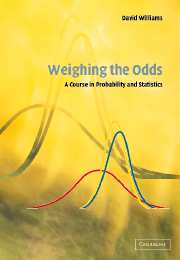Book contents
- Frontmatter
- Contents
- Preface
- 1 Introduction
- 2 Events and Probabilities
- 3 Random Variables, Means and Variances
- 4 Conditioning and Independence
- 5 Generating Functions; and the Central Limit Theorem
- 6 Confidence Intervals for one-parameter models
- 7 Conditional pdfs and multi-parameter Bayesian Statistics
- 8 Linear Models, ANOVA, etc
- 9 Some further Probability
- 10 Quantum Probability and Quantum Computing
- Appendix A Some Prerequisites and Addenda
- Appendix B Discussion of some Selected Exercises
- Appendix C Tables
- Appendix D A small Sample of the Literature
- Bibliography
- Index
5 - Generating Functions; and the Central Limit Theorem
Published online by Cambridge University Press: 05 June 2012
- Frontmatter
- Contents
- Preface
- 1 Introduction
- 2 Events and Probabilities
- 3 Random Variables, Means and Variances
- 4 Conditioning and Independence
- 5 Generating Functions; and the Central Limit Theorem
- 6 Confidence Intervals for one-parameter models
- 7 Conditional pdfs and multi-parameter Bayesian Statistics
- 8 Linear Models, ANOVA, etc
- 9 Some further Probability
- 10 Quantum Probability and Quantum Computing
- Appendix A Some Prerequisites and Addenda
- Appendix B Discussion of some Selected Exercises
- Appendix C Tables
- Appendix D A small Sample of the Literature
- Bibliography
- Index
Summary
ORIENTATION. Sums of IID RVs are of central importance in both Probability and Statistics. Pmfs and pdfs are not that easy to use: for example it is already rather tricky to find the pdf of the sum of n IID RVs each with the uniform U [0,1] distribution. To handle sums of IID RVs effectively, we need new methods; and generating functions provide these.
The main result in this chapter is the miraculous Central Limit Theorem (CLT) which says that the sum of a large number of IID RVs each with ANY distribution of finite variance has approximately a normal distribution. The normal distribution is therefore very special in this sense: we discover why. (We shall see later that the normal distribution is very special in several other ways, too.) There are at least three nice methods of proving the CLT, the first by generating functions, the second by using the fact that one can find the sequence of sums of IID Variables within a ‘Brownian-motion’ process, and the third (not quite so general) by using the maximum-entropy property of the normal distribution. We take a heuristic look at the first of these. Section I.8 of Volume 1 of Rogers & Williams [199] describes the second method: it requires much more background material. For hints on the maximum-entropy method, see 198H below. Historical note: The first case of the CLT was proved by de Moivre in 1706!
Some results in this chapter are too difficult to prove in full at this level; but precise statements (and, sometimes, sketched proofs) of the results are given.
- Type
- Chapter
- Information
- Weighing the OddsA Course in Probability and Statistics, pp. 141 - 168Publisher: Cambridge University PressPrint publication year: 2001



